Sports: India
This is a collection of articles archived for the excellence of their content. |
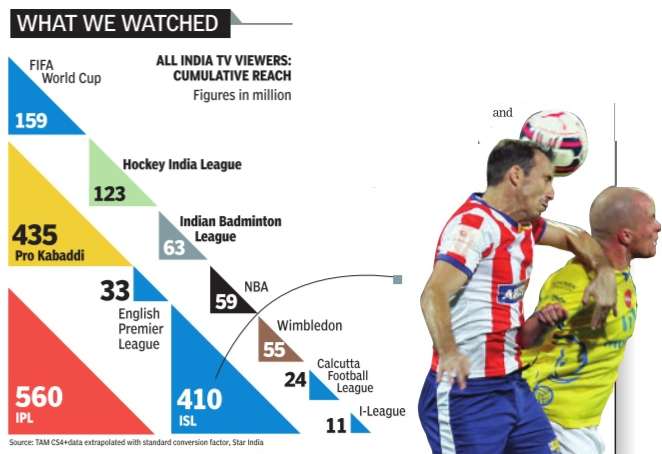


Controversies in sports
India Today, December 29, 2008
Cricketers vs BCCI
The BCCI has never been a novice when it comes to controversies. Even in 1989, six cricketers—Dilip Vengsarkar, Kapil Dev, Ravi Shastri, Arun Lal, Kiran More and Mohammad Azharuddin—took it to court over contracts. In October 1989, India Today reported,“ The showdown has caused a new rethinking on the board’s structure.”
Padukone vs BAI
Prakash Padukone, India’s greatest badminton player, became the unusual leader of a revolution when he set up the Indian Badminton Confederation as a rival to the Badminton Association of India (BAI), causing a schism in the sport. He wanted to reform the way badminton was played in India. “For a man like Padukone to have behaved so out of character is indicative of the magnitude of the problem,” said India Today in March 1996
Gill drops six senior players
This was the decisive crushing of player power. In 1998, IHF President K.P.S. Gill celebrated the Asian Games hockey gold by sacking the six most senior players. In March 1996, India Today had foretold the game’s death: “Everywhere this pungent smell of decay oozes from Indian hockey. Gill, inheritor of a disintegrating game in 1994, papered over some of the cracks but when an entire edifice is crumbling, a tube of quickfix is inadequate.”
Cricket match-fixing, since 2000
This is one controversy cricket-crazy Indians will never forget. It all started in 2000, with the Delhi Police tapping South African captain Hansie Cronje’s phone and stumbling on names that spelt match-fixing. India Today said in April 2000, “A mortar round has been fired into cricket’s stomach and it’s no good if administrators bring out a box of band-aids.” A number of names tumbled out of the closet including Indian skipper Mohammad Azharuddin. The word bookie entered our everyday vocabulary. There was nothing gentlemanly left in the Gentleman’s Game.
Milkha Singh turns down Arjuna Award
In an interview to India Today in September 2001, the Flying Sikh had said, “the prestigious award has been reduced to a tamasha”. More dirt was dug up. From the unappreciated Kanwaljit Sandhu, the first Indian woman to win an international athletics gold, to the moving plight of Makhan Singh, the only one to break Milkha’s record.
Pratima tests positive for dope at Athens
A shocked country looked on as Pratima Kumari was banned from the event and for life at the Athens Olympics 2004, for testing positive for drugs. While she blamed her coaches, they pointed at her personal trainers and even on her habit of turning up inebriated for training. Since 2004, no less than 113 Indian athletes have been accused of doping. India Today reported in September 2004 that the International Weightlifting Federation president had threatened to suspend the Weightlifting Federation of India, saying: “These positive cases have demolished your country’s prestige.”
Chappell vs Ganguly
It became the clash of the titans, which divided the entire cricket fraternity.Aleaked e-mail to the BCCI exposed coach Greg Chappell’s stance on skipper Sourav Ganguly in which he had doubted the latter’s behaviour, physical form and team spirit. Ganguly accused the coach of pitting players against one another. The result: “Chuck a pebble into the team bus and the chances of it striking a conflicted player are high,” reported India Today inOctober 2005.
Sania’s fatwa controversy
After storming the international tennis circuit in 2003, Sania Mirza has never been left alone. Fatwas were issued against her for her clothes to which she replied, “Some say Muslim girls shouldn’t wear mini-skirts, others say I’ve made the community proud. I hope God forgives me... but you have to do what you have to do.” (India Today, January 2005). Sometimes she bent to the furore and refused to play, but mostly, Mirza just let her racquet do the talking.
India Fails to qualify for Olympics Hockey
Indian hockey has seen it all. Good days, from 1928 to 1956 when it won six Olympic golds in a row, and the worst being its failure to even qualify for the games in 2008. A long history of maladministration and insularity on the IHF’s part led to this shocking elimination. The poor run of the national game made India Today observe in March 2008, “Indian hockey can no longer be pined over like a lost love. It is a sick industry in need of restructuring. Otherwise let’s roll up all the astro turf and lock up the stadiums.” 10. VOLLEY FOLLY
Bhupathi vs Paes
They were India’s best hopes for an Olympic gold in tennis. But then Leander Paes and Mahesh Bhupathi decided they had had enough of each other. “The best way to deal with Bhupathi-Paes these days is to convince yourself that today for each man, the other does not exist” (India Today, June 2008).
Corporate sponsorships
The Times of India, Oct 17, 2011
‘Today, sport is much more than just entertainment or physical exercise’
The Sahara India Pariwar’s foray into the fast and furious world of Formula One – with its purchase of 42.5 % stake in F1 team Force India for a sum of Rs 500 crore — is yet another reminder of the company’s growing presence in the world of sport.
The Sahara Group has emerged as the biggest sponsor and promoter of sport in India. The shirts of the Indian cricket and hockey teams are synonymous with the company’s name. It also owns Pune Warriors, the IPL team which it bought at last year’s auction for Rs 1,800 crore. Add to that Rs 500 crore which the company spends for sponsoring the Indian cricket team and its financial presence cannot be ignored.
This is not all. Sahara is also spending in a big way in its bid to support Indian sportspersons training to win medals at the Olympic Games. It has adopted boxing, wrestling, archery, shooting, athletics and tennis and has under its umbrella 95 sportspersons preparing for the 2012 London Games, quite a few of them being medal prospects.
When the Indian hockey players revolted last year for not being suitably rewarded for their efforts, Sahara moved in with a cash award of Rs 2 lakh each for the players. The company was also instrumental in bringing the prestigious Laureus World Sports Academy Awards to India in 2002 and 2003.
This is not to say that others in the corporate world do not have a connect with sport. Hero, earlier Hero Honda, is one of the major investors. With a budget of Rs 100 crores, they have long-standing forays in golf, cricket and hockey, and like Sahara, also co-sponsored the 2010 Commonwealth Games.
It is a similar case with multinationals like Coca Cola and Pepsi or tyre giants MRF and JK. Coca Cola spends a couple of million dollars on talent-hunting programmes in cricket, while Pepsi does the same though figures are not available. Communication bigwigs Airtel and Nokia spend around Rs 50 crore each annually primarily on cricket, while MRF and JK mainly spend on supporting motorsports in the country.
The Tatas have been among the pioneering big spenders in Indian sport, with others taking the cue from them. They started off by employing several top sportspersons. Their flagship endeavours were the Tata Football Academy, an athletics stadium and the archery academy in Jamshedpur. Figures may not be available but of late their presence in Indian sport seems to have faded a bit.
The United Breweries (UB) Group is another active sports sponsor and promoter in the country, and would come close to Sahara in its spending but figures are not readily available in this case either.
Mention must be made of the Indian Tobacco Company (ITC), a busy cricket sponsor some years ago, which has been forced to pull out due to regulations on tobacco Their withdrawal brought Sawhich make them ineligible to pro- hara to the fore as Indian crickmote or sponsor sports.
Sahara's major buys/sponsorship
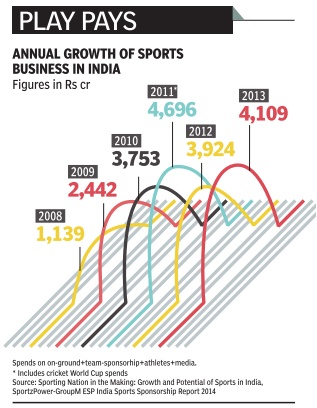
1,800 CRORE for IPL franchisee 'Pune Warrior India'
500 CRORES as Indian cricket team sponsorship till 2013
500 CRORE (approx) on the acquisition of Force India (now Sahara Force India)
TOTAL: 2,800 CRORE
Besides this, Sahara sponsors six other sports and 95 individual sportspersons
Other top sponsors in Indian sport
HERO MOTOCORP: One of the major investors in the sports arena whose annual budget is around Rs 100 crore. The company has exposure in cricket and IPL, golf and hockey.
COKE: The company is believed to be spending a couple of million dollars on U-16 cricket, football tournaments.
PEPSI: Runs a 'pacers' programme, a grassroot-level initiative to identify talent in the sphere of bowling. Selected bowlers are trained by experts. JK TYRE: They have spent Rs 100 crore on sports promotion, primarily motorsports, in the past 10 years.
AIRTEL: Rs 50 crore annually on sports
NOKIA: Rs 50 crore annually on sports
ITC: Used to be a big sponsor but is ineligible for any sports promotion now, because of ban on tobacco advertising.
Foreign clubs
Indian sportsmen in foreign clubs
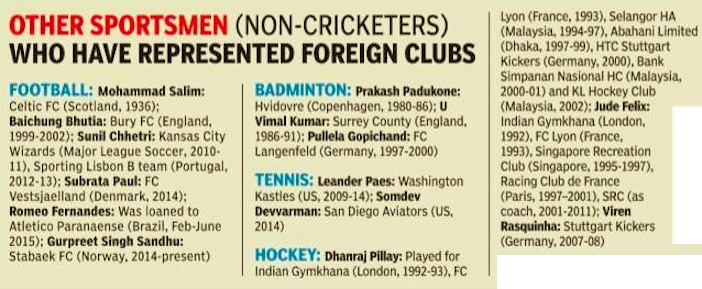
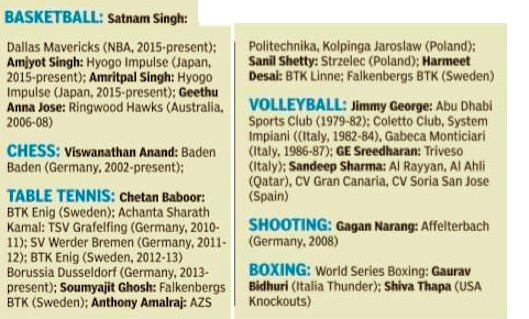
See graphics, Indian sportsmen in foreign clubs-I
Indian sportsmen in foreign clubs-II
Multi-country tournaments and India
India at the Asiad, CWG and Olympics
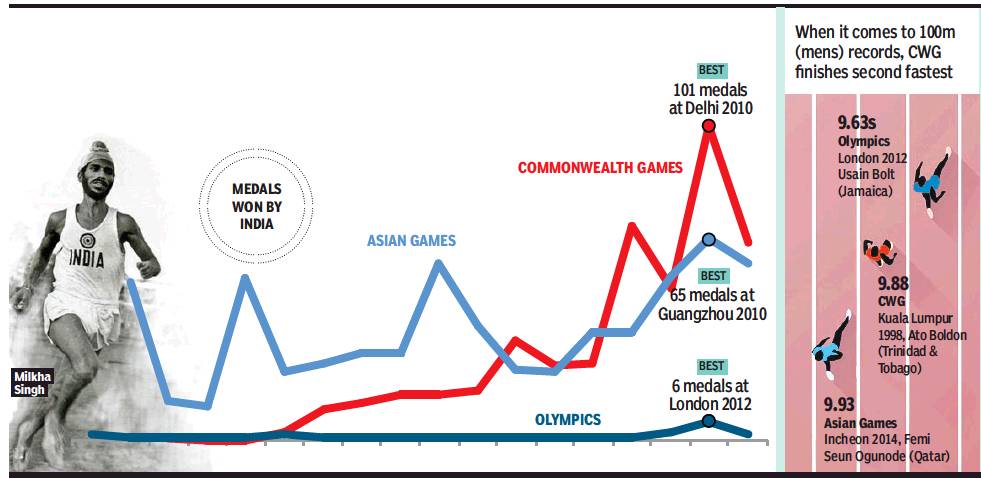
From: April 8, 2018: The Times of India
See graphic:
India’s medal tally at the Asian Games, Commonwealth Games and the Olympics, 1958-2016
Near Misses
1960-2016
The Times of India, Aug 29 2017
Many are already calling PV Sindhu's effort as one of the most enduring in Indian sport. Dhananjay Roy takes a walk down memory lane to pick a few of those special times when the contest left the Indian sportsman and the fan physically and emotionally drained...
PT USHA (1984 Los Angeles Olympics)
PT Usha was at the peak of her powers and was a real hope in the 400m hurdles. Usha clocked 56.81 sec in the heats and 55.54 sec in the semifinals.In the final, she clocked 55.42 sec, finishing fourth, trailing the eventual bronze-medallist by an agonizing 1100th of a second.
MILKHA SINGH (1960 Rome Olympics)
Milkha Singh had been clocking impressive timings in the run up to the Games and had beaten most of the top contenders at various meets. Expectations were sky high, but the Flying Sikh miscalculated his run when it mattered most and finished fourth. That's a memory that still rankles the great sprinter.
LIMBA RAM (1992 Barcelona Olympics)
The archer came closest to Olympic podium at the 1992 Games in Barcelona. Just ahead of Barcelona, Ram had equalled Takayoshi Matsushita's world record in the Beijing Asian Archery Championships in the 30m event with a score of 357360 for gold. Fans were counting on him for a repeat performance in the Olympics.However, he fell short by a single point in the 70m competition, and missed out on the bronze.
LEANDER PAESMAHESH BHUPATHI VS IVAN LJUBICIC MARIO ANCIC (2004 Athens Olympics)
In 2004, the pair of Leander Paes and Mahesh Bhupathi was rated as the finest doubles players in the world. All of India was certain that the duo would return with a medal from Athens. Things did not go as per plan and they were beaten by the wild card Croatian pair of Mario Ancic and Ivan Ljubicic in the bronze-medal play-off. The Indians had numerous opportunities to shut out the match, but were pipped 6-7 (5), 6-4, 14-16 in three hours and 58 minutes in a nerve-racking contest that began on a Friday night and ended in the early hours the next day.
ABHINAV BINDRA (2016 Rio Olympics)
India's only individual gold medallist at the Olympics came extremely close to winning another medal before he ended up finishing fourth in the 10m air rifle event in Rio. Tied on 163.8 points after 16 shots with the eventual silver-medallist Serhiy Kulish of Ukraine, Bindra shot a 10.0 to Kulish's 10.5, depriving the Beijing Games gold winner of a fairytale ending in his fifth Olympics.
INDIA VS KOREA: MEN'S HOCKEY FINAL (2002 Busan Asian Games)
Defending champions India fell to hosts Korea 4-3 in the final despite putting up a courageous display. They were buoyed by a splendid 4-3 win over a strong Pakistan side in the semifinals and young defender Jugraj Singh almost did the star turn for India. But his shoulder-charge of an opponent led to a penalty corner off which the Koreans scored the winner in front of a stadium packed with members of the Indian contingent who had come to see an Indian triumph.